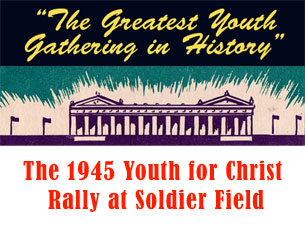On a Memorial Day weekend in 1945 some seventy thousand Chicagoans gathered at the cavernous Soldier Field to commemorate Americans who had given their lives in the soon to be resolved world war. Patriotism, however, was not the only item on display. Just as significant for the capacity crowd crammed into Chicago’s largest forum was the celebration of a new youth movement sweeping the country. Youth for Christ (YFC), marking its first birthday, was a national phenomenon, already holding large regular rallies in almost four hundred cities and towns across America with combined attendance of almost half a million. On this Friday evening the enthusiastic crowd swooned to the music of the large orchestra, the five thousand member choir and the deep throated solos of George Beverly Shea.
The patriotic program featured war heros, young cadets and patriotic nurses. It also included a missions program. Youth dressed in the costumes of the world reminded the Soldier Field crowd that beyond the war to save the world from fascism lay another mission for America–saving the world from sin. A young evangelist named Billy Graham called for a new revival to change America and the world. Newsweek magazine, the Chicago media and national newspapers covered the spectacle. William Randolph Hearst ordered his twenty-two newspapers to cover future Youth for Christ rallies. Within a few years YFC would boast a thousand Friday night rallies held around the country with a million young people in attendance. Evangelists for the youth organization were traveling around the world bringing the message of revitalized evangelicalism to some forty-six countries by 1950. For historian Joel Carpenter, “Youth for Christ was one of the most striking early signs of a rising new evangelical movement,” a movement that “has remained a prominent factor in American life since then.”
During the war American evangelicalism took important steps out of their marginalized subculture towards the center. The National Association of Evangelicals (NAE) was formed in 1942. “New hope for a revival,” writes Joel Carpenter, “was prominent in the message of the first conventions of the” NAE. Harold Ockenga in his inaugural address as the first president of the NAE saw the war as a crossroads for the world. One path meant “a return to the dark ages” and the other “the rescue of western civilization by a . . . Revival of evangelical Christianity.” Many evangelical leaders across America echoed similar convictions. In southern twangs and broad Midwestern tones American religious leaders seemed to agree with Dostoyevsky that civilization had only two choices: God or nothingness.
I like Wacker’s take on the uneasy soul of the evangelical in America. I have felt these same tensions in my own soul. In light of global revivals, I would add one additional footnote to Wacker’s argument about the custodial and the plural ideals. The postwar revival was not only a destabilizing response to modernity but also a corrective response. In the 1970s, Billy Graham and his brand of evangelicals chose to move beyond the revitalized custodial ideal (read “saving my nation”) into a revitalized plural ideal (read “blessing the nations”) that helped forge a global network of international and culturally diverse evangelicals. As this network grew, global evangelicals, often products of local revivals, were granted an equal status in world mission and empowered to take an active role in a holistic mission to the ends of the earth. Ironically, the creation of this international evangelical network has helped give strength to the custodial ideal as American Christians struggle with the call for gay marriage and other social issues and have looked to Balokole African bishops for support.
Seen in this way the significance for world Christianity of the evangelical postwar revival has less to do with the rise of the religious right or the exporting of American religion than it does with the creation of an international evangelicalism, independent enough from its American component to be unique and yet connected enough to its common mission in the world to be a significant partner. Beginning with Lausanne and the unleashing of global voices, a Latin American evangelical social engagement, an East African revival piety of the cross, an Asian Christian quest for dialogue and witness in a religiously plural context, collided with American middle-class evangelicalism and altered it forever. Though fundamentalists would grab the custodial ideal from the hands of Billy Graham and his new evangelicals, Lausanne ensured that the missionary and pluralist ideal of the book of Acts and the Great Commission of Christ was quickened. The two-way traffic on that broad and busy highway produced a great and global awakening that encouraged many new Jerusalems to become centers of holistic mission, even to the West.
The voices of Soldier Field on that windy Memorial Day in 1945 announced the twin goals of national renewal and world evangelism. Those voices, almost silenced by the sixties, almost drowned out by the angry shouts of the 1980s, have now become part of a global chorus reaffirming Torrey Johnson’s twin goals on a global scale. Johnson simply had them in the wrong order. |



